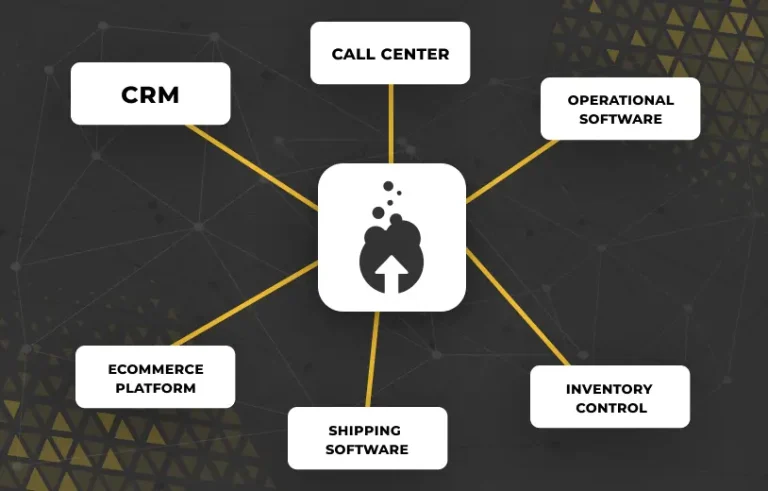Key Takeaways
- Middleware integrates diverse IT applications, ensuring seamless data flow and operational efficiency.
- Development options include in-house, third-party providers, and custom development through agencies, each with pros and cons.
- Key factors for selecting middleware include scalability, compatibility, cost, support, and maintenance.
- We highlight six leading middleware technologies, offering insights into their strengths and weaknesses.
- Choosing the right middleware improves data integration, reduces manual processes, and enhances user experiences.
The average organization with 2,000 employees will have 88 different IT applications.
These will cover everything from sales, marketing, finance, IT and HR. They will likely be developed and supported by different vendors. And this is before we even get to specialist applications.
For years, the only way to get data from one of these systems into the other was grueling manual processes – someone with an Excel sheet, porting data from one to the other. This is labor-intensive and error-prone.
With the introduction of middleware into your IT ecosystems, businesses can connect these systems into a unified data hub that shares data automatically without the need for long, error-prone spreadsheets or clunky, easily hacked file transfers.
The challenge is that there are lots of middleware options out there. Choosing the right one will enable data to flow seamlessly through your organization, breaking down silos between teams, mitigating risks, and allowing you to scale, all while creating a better experience for customers and staff.
Choosing the wrong one can lead to even more manual processes, higher staff turnover, and bottomless development costs, which are discussed at every board meeting.
Below, we provide a strategic guide to choosing middleware, including things to consider, elements to include in the project, and some middleware development technologies, with their strengths and weaknesses.

Options to Consider When Developing Middleware Technology
Selecting the right process is as important as selecting the right technology. When it comes to developing a middleware solution, there are generally three different options.
Inhouse Development
One option is using internal resources to develop your middleware connections in-house. This would involve utilizing an existing specialist or hiring one.
Pros:
In-house development is the most flexible option, allowing you to tailor your middleware solution to your desired specifications.
Cons:
It can take resources away from other projects, and it’s difficult to scale and maintain as your foundation technology is upgraded or changes. It often relies on a single person – if they become sick or leave the business, your operation is in danger.
Third-Party Providers
There are many out-of-the-box middleware providers who can offer standard software integrations. These can be purchased directly from the vendor and set up remotely.
Pros:
They do not require much setup, and the vendor handles the support and maintenance. They’re usually the cheapest option.
Cons:
Customization is limited, which can be a significant problem if you have existing workflows. You are at the mercy of the vendor’s charges and fees (upgrade costs can be significant). Support can be poor, especially if it’s outsourced.
Custom Development
Using an agency, you can leverage their expertise to develop a customized middleware option. This takes the form of a discrete project using their staff and resources. Often, support and maintenance can also be included.
Pros:
Provides the flexibility of an in-house build without the drain on resources or the need to hire technical specialists. It can be fully customized to your specifications. You can include options for support and maintenance.
Cons:
It requires more planning than out-of-the-box options and the cost is variable depending on the scope of the project. It’s important to pick the right partner as the wrong one can create more problems than it solves.
Considerations for Finding a Middleware Solution
Time and cost are obvious considerations. However, there are others to consider to ensure that your middleware project doesn’t encounter any speedbumps that need to be explained to the board.
Resources
How long is the project going to take, yes, but also whose time will be used? This is essential as internal resources are there for a reason, and taking them away from their day job to work on a new middleware project could cause business-critical delays in other areas.
Scalability
Once the first iteration of your middleware project is complete, your business will likely grow due to the additional efficiency provided. Once your business grows, it is important to think about how the middleware solution can be developed to manage increased volume or new applications. This is much easier to plan at inception than to try and fix on the fly.
Dependencies
Being completely reliant on a third-party vendor for support and maintenance can save a lot of time, but it also means you could be hit with unexpected costs and a gun to your head. It’s important to assess the level of dependency you are comfortable with before choosing your middleware path.

Top 6 Middleware Technologies
At Fahrenheit, we work with all types of middleware each and every day, providing out-of-the-box and custom developments based on specific customer needs and their chosen requirements.
With that experience, we have put together a list of middleware options that we recommend due to their flexibility, ease of use, and practical application:
Laravel
Laravel is fantastic for companies looking to develop their middleware quickly. It’s got a lot of template functionality and a great community. It also plays well with others, meaning you can easily add additional technology.
It is complex to use with a steep learning curve. This can increase costs due to the need to train staff or hire specialists. With its great flexibility, it may also require significant optimization at high volumes. For a real-world example, Trello uses Lavarel.
While the initial costs may be slightly higher due to the investment in training and infrastructure, Lavarel will scale better than most. We recommend this for fast-growing companies with a committed plan to scale.
Best Language: PHP
Developer Proficiency: 6/10
Symfony
Symfony is ideal for complex applications in specialized business areas. It has a long track record of timely and well-engineered updates, is among the most stable options, and offers an enormous depth of functionality.
This complexity requires skilled developers, which can increase headcount costs. The need for specialism can impact project timescales. Magneto uses Symfony for its applications.
Best Language: PHP
Developer Proficiency: 7/10
Yii
Yii’s strengths are twofold. It’s really quick, with high speeds and innovative caching solutions, which is great when high performance is required. This means that it is less server-intensive, which reduces costs. It’s also much simpler to use than other frameworks, reducing training time and resource burden.
Its simplicity comes with reduced customization, which could be a problem if you’re a specialist. Unlike some others on this list, its community is smaller, so support may be slower. Due to its simplicity, you may need to invest in additional tools, which can impact costs. CMS is a Yii solution.
Best Language: PHP
Developer Proficiency: 5/10
Express
Express is a developer’s dream because it’s lightweight and highly customizable. In the right hands, this can work for every application size, making it perfect for scale-up operations. The initial investment is small due to the power it gives your developers.
The downside is that it’s development-heavy as you really do start with the basics. Lots of development is essential to getting the most from Express. Depending on your requirements, additional modules or software may be needed to complement its core functionality. Due to its dependence on development, staff leaving could be problematic. PayPal utilizes Express in its applications.
Best Language: Java Script
Developer Proficiency: 4/10
Next.js
For companies interested in maximizing customer engagement, Next.js has built-in tools that enhance SEO and discoverability. Its focus is on experience, so its load times are small. The better the customer experience when utilizing middleware, the more likely you are to see conversions.
It is highly dependent on React, which limits its applicability and means that skilled developers are required to get the most out of it. Its niche application and the need for investment in hiring or training React developers are key considerations. Streaming company Hulu uses Next.js in its setup.
Best Language: Java Script
Developer Proficiency: 5/10
Django
Django’s specialty is security, with robust features designed to protect data from malicious actors. This security comes with a wealth of built-in features, which means you can deploy your solution quickly and securely (a rare treat). It’s excellent for companies handling sensitive information.
For smaller companies, the ecosystem can be overkill as you won’t likely use all of the functionality on offer. It’s also reliant on Python, so if your infrastructure is in a different language, there can be challenges. Instagram uses Django as its middleware.
Best Language: Python
Developer Proficiency: 7/10
Each of these technologies has trade-offs, which is why matching the right option to your business plan and meeting the requirements from your initial discovery sessions is essential. Things like security, scale, and speed are crucial to consider. This will ensure that your project meets the brief while remaining on time and within budget.

Middleware Implementation: CaseS Studies
With a reservoir of experience and a team of highly experienced developers, Farenhheit has the capability to work with companies at every stage of their middleware project – from the early discovery conversations through to the deployment of a complete middleware stack.
Our team is ready to help at any point to ensure your business is working the way it should be – efficient and cost-effective.
Below are examples from companies we’ve helped so you can understand what’s involved in a project with us:
Custom Work for Lammes Candies
Lammes Candies is a homegrown Texan confectionery company famous for its Chewie Pecan Praline. From humble beginnings 130 years ago, Lammes has successfully grown from a single Texas shop to a wholesale candy enterprise.
As they expanded their operations and started to focus on eCommerce, they began to encounter problems. The off-the-shelf product they were using had begun to fail due to the volume of orders, leading to manual workarounds that added huge drains on resources. It also impacted their customer satisfaction – which has always been Lammes’ highest priority.
The Ask
Lammes needed to reduce manual effort and increase efficiency by integrating their eCommerce platform into their shipping solution.
The new solution also needed to be simple enough for in-house IT to maintain while handling the increased volume of orders.
The Solution
After an in-depth discovery session with all major stakeholders, Fahrenheit Marketing suggested an approach via Laravel. The process involved custom integration between the eCommerce and fulfillment platforms.
This was fully documented, which meant the in-house team could maintain and support the integration themselves, making Lammes self-reliant.
The Outcome
Due to the improved integration, Lammes saw an immediate improvement in order processing. Fahrenheit Marketing provided all the documentation and developed the integration to the skill level of Lammes’ IT team, making the solution easy to maintain and cost-effective.
By utilizing Fahrenheit’s specialists, the project was completed without any impact on other projects in the business.
You can also view the Lammes Candies case study on the design and development work we did for them.
Custom Template for Our E-Commerce Clients
Several of Fahrenheit Marketing’s customers were facing the same problem. Large orders with lots of lines would come into the business.
Often, the exports and import templates wouldn’t match, so every order needed to be manually typed in one by one. This was causing significant issues.
Not only was it time-consuming, but customers were constantly receiving the wrong orders due to errors.
The Ask
Automate order processing so that users can import data easily and securely. Remove the need to type orders or use Excel. Improve the consistency of orders going through their eCommerce systems to increase customer satisfaction.
The Solution
After working with clients and understanding their key requirements, Fahrenheit created the Offline Importer. Using Laravel middleware, the importer could automatically process user data via simple spreadsheets. Fahrenheit implemented error detection to reduce incorrect orders being sent out and a bespoke search tool, allowing users to filter their data and report on it easily.
All of this was done with safeguarding in mind, meaning that clients’ customers were protected and clients themselves were PCI compliant.
The Outcome
Every client experienced a dramatic increase in customer satisfaction. Internally, the Offline Importer gave staff the freedom to work on other tasks, which boosted efficiency. There was also a net positive impact on staff turnover due to the stress relief the importer provided.
The boards and owners of each client were finally able to have accurate reporting, which enabled more precise strategic planning.
Because the Importer could be deployed immediately and out of the box, with almost no training required, Fahrenheit Marketing’s clients implemented the solution with near-zero downtime.

Let Fahrenheit Marketing Help You With Your Middleware Needs
Once you have decided to look at a middleware solution, the first consideration is who will build it. The options range from a labor-intensive but flexible in-house build to a cheap but rigid out-of-the-box solution.
Custom development is the middle ground, being more flexible than out-of-the-box and less labor-intensive than in-house builds.
Understanding the bottlenecks is essential to your project’s success. Often, these will come in the form of resources, future scalability, and support dependency.
All of these items can impact the running costs of a middleware project, so they need to be factored in at the start of your project.
Choosing the right middleware for your business is essential. Key things to consider are setup speed, ease, and development proficiency (to ensure you can keep the lights on). Choosing the right partner is as important as choosing the right software. Fahrenheit can help at any point on this journey.
From high-level consultancy to building your solution from scratch, we have the expertise to guide project plans, bridge resource gaps, and develop your vision.
Contact us today for a free consultation and find out how we can take the headache out of middleware.
